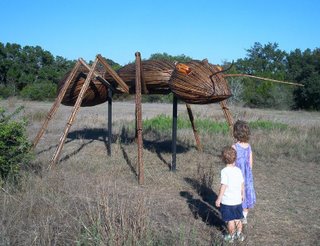
This guy was killed in our backyard on Wed May 6 at 7:45 pm. This picture is of him dead at the bottom of our small-sized city trash can. His tail continued to whip around for a good hour after he was killed!
Red against Yellow: kill a fellow
Red against Black: venom lack
Don't bother memorizing the rhyme, just stay away from all bright-colored snakes!
TEXAS CORAL SNAKE, Micrurus fulvius tener
This snake has red, yellow, and black bands encircling the body, with the red touching the yellow. It is a slender snake averaging 2 feet in length. These snakes feed mainly upon other snakes and sometimes lizards, so they are attracted to yards landscaped with timbers or flagstones, since that tends to attract the other smaller snakes on which they can feed. In other parts of Texas, there are found several other snakes which mimic the coral snake's colors, but these snakes are not common to this area. In Austin, if it looks like a coral snake, it probably is one, as they are somewhat common to this area.
Though locally common in suburban neighborhoods throughout all of the state but far West Texas, M. fulvius is so secretive and nonaggressive toward human beings that only those who handle the snake are often bitten. Although venomous, these snakes have a hard time injecting venom into a human because of their small head and their short, fixed fangs. The rigid fangs are less than one-eighth inch in length and are unlikely to penetrate shoes or even most clothing, although corals can pierce a pinch of skin anywhere on the body. Bites usually occur only on the hand on or between the fingers. They are usually encountered by people gardening or weeding. Wearing thick gloves is the safest way to avoid problems with the coral snake while gardening. Snakes do not prey on humans and they will not chase you, in fact they usually retreat or escape if given the opportunity. The danger comes when they are either surprised or cornered. If molested, the coral snake is a quite determined biter that flips its head from side to side and snaps sharply. Do not play around with a dead snake, they have been known to bite and envenomate.
Coral snake venom is largely composed of neurotoxically destructive peptides and is, therefore, more deadly than the venom of any other North American reptile. A lethal dose for an adult human being is as small as five to ten milligrams, dry weight-several times more virulent than the venom of the western diamondback rattler (see RATTLESNAKES). Since its toxic peptides spread rapidly through the blood stream, the application of a tourniquet and immediate hospital administration of antivenin are probably appropriate in cases of severe poisoning. Although intense pain usually accompanies a bite, heavy envenomation is often difficult to determine because the central nervous system may not manifest symptoms for several hours. No deaths related to coral snake bites have been reported in the United States since coral snake antivenom became available. Before that time, the estimated case-fatality rate was 10%, and the cause of death was respiratory or cardiovascular failure. Patients who survive the bite may require respiratory support for up to a week and may suffer persistent weakness for weeks to months.

2 comments:
I never could remember the rhyme
Red on yellow kills a fellow
red on black, tasty snack
Red on yellow happy marshmallow
red on black, give it a whack
I just could not keep up, so? when I see a snake, I run. And that's where the danger lies. Trees.
Snake! run run run SMACK! into a tree....
I've never known anyone to see this species except TV personalities. So glad you didn't get hurt!
Post a Comment